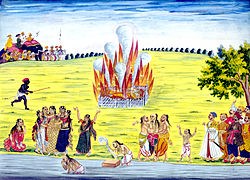Sati (practice) From Wikipedia, the free encyclopedia
Jump to navigation Jump to search "Suttee" redirects here. For other uses of "sati", see Sati (disambiguation).

An 18th-century painting depicting sati.
Sati or suttee[note 1] is an obsolete funeral custom where a widow immolates herself (Anumarana) on her husband's pyre or takes her own life in another fashion shortly after her husband's death.[2][3][4][5]
Mention of the practice can be dated back to the 3rd century BCE,[6] while definite inscriptional proof in Nepal and India starts appearing from 5th and 6th centuries CE respectively. Sati stones started appearing in large numbers from 11th century. From 12th to 19th century and also in the late modern era, there were incidents when it often occurred in large numbers, especially as a reaction to military conquests by foreign militaries. The number of women burning themselves however always remained low in relation to the number of people. Resolute support for Sati by some authors only appears from 15th century, however there were also many in opposition to it. The practice was particularly prevalent among some Hindu communities,[7] observed in aristocratic Sikh families,[8] and has been attested to outside the Indian subcontinent in a number of localities in Southeast Asia, such as in Indonesia and Vietnam.[9] The practice was never widespread throughout India, nor did it have scriptural sanction.[10]





















comment:
p_commentcount